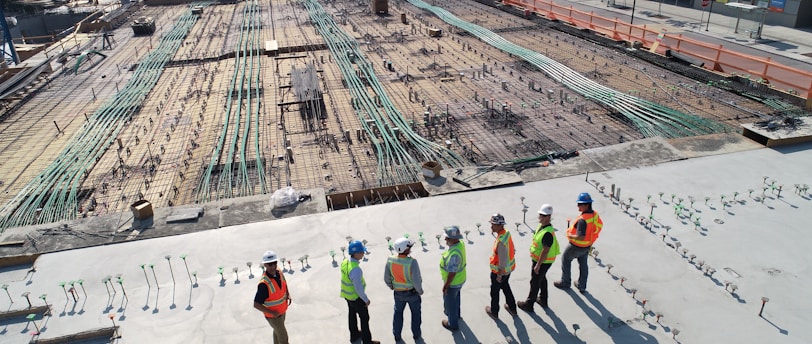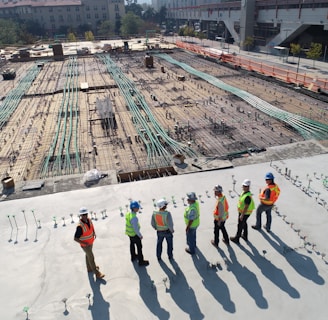
Building Tomorrow: Navigating Challenges in the 2024 UK Construction Landscape
Experts predict a bounce back for the construction industry in 2024. We take a look at some potential areas of focus
L Joseph
12/28/20233 min read


As we step into 2024, the construction industry stands at the cusp of renewal, poised for a robust bounce back. The challenges of the past are giving way to new opportunities, reshaping the trajectory of the sector. A recent Construction News report, supported by Glenigan's industry forecasts, sheds light on the evolving dynamics, hinting at a promising yet complex future for construction companies.
The Road to Recovery: Forecasting Construction Industry Trends 2023 - 2025
Glenigan's latest construction industry forecasts paint a nuanced picture. The underlying value of construction starts, particularly projects with a construction value of less than £100 million, is expected to experience an improvement in the coming months. However, the year 2023 is anticipated to see a decline of 18% compared to the previous year, echoing the lingering effects of economic slowdown and structural changes.
Emerging Opportunities: Sectors Set to Drive Growth
In the face of these challenges, the construction industry is gearing up for renewed growth in 2024 and 2025. A strengthening UK economy is poised to lift consumer and business confidence, leading to increased activity in various sectors.
1. Consumer-Related Areas: Improved household spending and consumer confidence are anticipated to drive growth in consumer-related areas, with a notable rise in office refurbishment projects. The evolving post-pandemic working practices are prompting the remodelling of office spaces to accommodate new norms.
2. Logistics Facilities: The surge in online retailing is expected to act as a catalyst for renewed investment in logistics facilities from 2024. The demand for warehousing and logistics space is likely to experience a notable uptick, presenting opportunities for construction companies.
Short-Term Opportunities: Public-Sector Investments as a Beacon of Hope
While the private sector is expected to take the lead in generating opportunities from 2024 onwards, the near-term landscape is dominated by public-sector investments. Constrained by high inflation rates, increased taxes, and rising mortgage costs, consumer-related areas like private housing, retail, and hotel & leisure are turning to public-sector investments for growth.
The expected £4.9 billion underspend by government departments during the last financial year is anticipated to fuel increased government investment in 2024. Public sector construction, therefore, is poised to be a bright spot in 2023, particularly in areas such as education, community & amenity, and health sectors.
Sector-Specific Growth: A Glimpse into the Future
1. Education Sector: The education sector is set to experience the highest rate of growth in 2023, with an 18% increase in the value of underlying starts. Commitments to rebuild schools and capital funding boosts indicate a positive trajectory.
2. Health and Community & Amenity Sectors: Growth in the health and community & amenity sectors is anticipated to materialize in 2024, with respective increases in underlying starts of 13% and 17%. NHS investment remains a high political priority, driving a real-term growth rate in NHS capital funding.
Private Sector's Role in the Rebound: From 2024 Onwards
From 2024, the private sector is expected to take the reins in generating opportunities for the construction industry. Key sectors anticipated to contribute to this rebound include:
1. Industrial Sector: The underlying value of starts in the industrial sector is forecasted to boom by 20% in 2024, fuelled by growth in warehousing & logistics sub-sector. The continued shift towards online retailing is expected to sustain demand for logistics space.
2. Office Sector: Underlying starts in the office sector are forecasted to leap by 20%, driven by refurbishment and fit-out work. The repurposing of redundant premises, such as the proposed redevelopment of the St Enoch shopping centre in Glasgow, presents additional openings.
Navigating Challenges: The Planning Regime and Housing Sector
While opportunities are on the horizon, challenges persist. Changes to the planning regime, initially impacting volume housebuilders, may yield positive outcomes in other areas. The reform of leasehold property regulations and post-Grenfell safety regulations may enhance enthusiasm for new apartments, potentially increasing competition with build-to-rent developers for high-rise city centre sites.
Regional Shift: A Focus on Northern England and 'Levelling Up'
The construction markets in the northern half of England are forecasted to outperform London and southern England up to 2025. Government funding and policy shifts towards 'levelling up' are reflected in the regional focus, with the Levelling Up Fund injecting £4 billion to support projects across the country.
Strategic Positioning: Building Tomorrow, Today
As the industry navigates this evolving landscape, strategic positioning becomes paramount. Firms must target emerging opportunities, aligning expertise and resources to capitalize on growing markets and locations. The rebound of the construction industry is not only about overcoming challenges but also about leveraging newfound opportunities to build a resilient and prosperous future.
In conclusion, the construction industry in 2024 holds the promise of resurgence, driven by new opportunities and strategic foresight. Construction companies, armed with resilience and adaptability, can position themselves to play a pivotal role in shaping the built environment of tomorrow. Now is the time to plan, invest, and build the foundation for a robust and dynamic construction sector in the years ahead.
Contact
20 - 22 Wenlock Road
London N1 7GU
info@idlresources.com
+44 (0)203 879 0925
